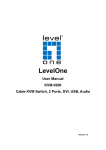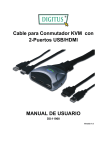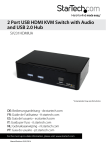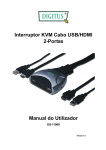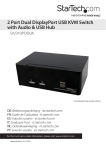Download Digitus DS-11402-1 KVM switch
Transcript
2-Port Pocket USB KVM switch Users Manual (DS-11402-1) Index 1. INTRODUCTION……………………………………………………………………………………………2 1.1 FEATURES …………………….…..………………………………….………………………… ………2 1.2 PHYSICAL DIAGRAM…….…………………………………...…..………………………………………3 1.3 PACKAGE CONTENTS…………………………………...……………..………………………………...3 2. SPECIFICATIONS………………………………………………………………………………………….4 2.1 GENERAL……………………………………………………………...…………………………………4 3. INSTALLING THE CABLE KVM SWITCH………………………………………………………………5 3.1 SYSTEM REQUIREMENTS………………………………………….…………………………………….5 3.2 HARDWARE INSTALLATION………...………………………...……………..……………………………5 3.3 HOT SWAPPABLE……………………….……………...……………………..………………………….6 3.4 DRIVER INSTALLATION(WINDOWS 98/SE ONLY)..………………………………………………………6 4. OPERATION………………………………………………………………………………………………..9 4.1.PUSH BUTTON OPERATION ................................................................................................. 9 4.1.1.PC SELECTION ............................................................................................................... 9 4.1.2.AUTO-SCAN .................................................................................................................... 9 4.2.HOT KEY OPERATION ....................................................................................................... 10 4.2.1.PC SELECTION ............................................................................................................. 10 4.2.2.AUDIO SELECTION ......................................................................................................... 10 1 1. Introduction Thank you for your purchase of the 2-port USB/VGA Cable KVM Switch with Audio! You now have a high quality, durable system that enables you to control two computers and/or servers from one console (USB Mouse, Keyboard, and Monitor). In addition, proprietary new technology allows you to independently control and switch audio between two computers. 1.1 Features 1. Controls 2 computers from a single console (Keyboard/Mouse) over USB connection. 2. Support Windows (98SE or above), Sun Micro , Mac , Linux 3. Supports speaker and Microphone. 4. Emulates a keyboard on each PC to allow your computers to boot normally without a keyboard error. 5. Supports hot-swap. All devices connected to the KVM can be added or removed at any time, without shutting the unit down. 6. Supports USB keyboard Hot-Key Switch (for Microsoft Windows series) and push buttons for easy operation. 7. Supports Auto-Scan function to alternate video between both computers in preset intervals. 8. Supports LED display for PC and audio status monitoring. 9. Supports VGA resolutions up to 2048x1536 @ 85HZ. 10. Supports Plug and Play. 11. Self powered through USB connection. 12. Supports independent audio switching. 2 1.2 Physical Diagram PC connection 2 LED Indicators (Green) PC connection 1 LED Indicators (Green) PC 1 LED Indicators (Red) PC 2 LED Indicators (Red) USB Keyboard VGA Output USB Mouse PC Selection Push Button PC Selection Push Button Speaker Jack MIC Jack PC LED Indicators: RED LED indicates that the 2-port USB/VGA Cable KVM Switch is switched to the corresponding PC. PC connection LED Indicators: GREEN LED indicates the status of PC connection. 1.3 Package Contents The product you purchased should contain the following equipment and accessories: 1. One 2-port USB/VGA Cable KVM Switch with Audio. 2. User Manual. 3 2. Specifications 2.1 General Specification Number Of Computers Controlled Selection Method USB Versions supported LEDs PC Connectors USB Video Speaker Microphone 2 USB Keyboard Hot Key and Push button 1.1/2.0 Red for PC Selection Green for PC ON-Line Selection 2 x Type A USB Connectors 2 x HDB-15 male 2 x Stereo speaker plugs 2 x Mono microphone plugs KVM Body Keyboard / Mouse Console Ports Video Speaker Microphone HOST Auto-Scan Interval DDC, DDC2 monitor Hot Swappable 1 x DVI 24+5 Connector (male) 2 x Type A USB Connectors (female) 1 x HDB-15 female 1 x Stereo speaker jack 1 x Mono microphone jack 1 x DVI 24+5 Connector (female) 10 Seconds Yes (Max. Resolution: 2048x1536)@85Hz Yes Operating systems supported Windows (98SE or above), Sun Micro, Mac, Linux Device driver Power Cable Length No By PC USB power 1.20 Meter Dimensions (LxWxH) Unit Weight 65 x 85 x 25 (mm) 450 g 4 3. Installing the Cable KVM Switch 3.1 System Requirements (1) A PC with USB port and 1 VGA port. (2) Windows 98 or later, Mac OS 8/9/OS X, Linux Kernel 2.3 or later. (3) USB Keyboard and mouse. (4) Monitor with VGA port. 3.2 Hardware Installation 5 Plug the USB keyboard, USB mouse, and monitor into the corresponding connectors of your 2-port USB/VGA Cable KVM Switch. Plug the speakers into the corresponding jacks of your 2-port USB/VGA Cable KVM Switch. Connect the KVM cables into the corresponding ports on the computers. 3.3 Hot Swappable The 2-port USB/VGA Cable KVM Switch supports hot-swap technology. All the components can be added or removed at any time without shutting the PC down. 3.4 Driver Installation (Windows 98/SE only) After you connect the 2-port USB/VGA Cable KVM Switch to your PC, Win 98 will automatically detect the device and prompt for the driver installation. Please install the 2-port USB/VGA Cable KVM Switch by the following instruction from Step A-E. Please have your Windows 98 CD ready. A. Press “Next” to Continue. (Ref. Fig. A) Fig. A B. Select “Search for the best driver for your device” and press “Next” to continue. (Ref. Fig. B). Fig. B 6 C. Please insert the “Windows 98” CD into your CD-ROM drive. Click “CD-Rom drive” and press “Next” to continue. (Ref. Fig. C) Fig. C D. Press “Next” to start the installation process. (Ref. Fig. D) Fig. D D1. Sometimes Windows cannot locate the necessary driver automatically. So you need to choose “Browse” to specify the location of the driver on your “Windows 98” CD manually. * (Ref. Fig. D1) Fig. D1 7 * The driver might be located in a different directory from the figure above. D2. Press “OK” to continue (Ref. Fig. D2) Fig. D2 E. Press “Finish” and Windows has finished installing the USB Human Interface Device driver for PS/2 keyboard & mouse. (Ref. Fig. E) Fig. E 8 4. Operation The 2-port USB/VGA Cable KVM Switch can switch the keyboard, video, mouse by pushing button and Hot Key. The switching of Audio inputs (speaker & microphone) is independent and be controlled by Hot Key only. The Audio inputs is not be switched with PC selection. 4.1. Push Button Operation 4.1.1. PC Selection User can switch Computers (Keyboard, Mouse and Video inputs) by pressing push button directly. 4.1.2. Auto-Scan Start Auto-Scan Press and hold push button for longer than 3 seconds will turn the system into auto-scan mode. The auto-scan time interval is fixed to 10 seconds. Stop Auto-Scan Under auto-scan mode, press any push button will stop auto-scan. 9 4.2. Hot Key Operation When using the Hot Key sequences, the keys must be pressed within 6 seconds, otherwise the Hot Key action will terminate. The Hot Key Operation is only supported under Microsoft Windows series system. 4.2.1. PC Selection [ScrollLock] + [ScrollLock] → 4.2.2. Audio Selection [NumLock] + [NumLock] → Hot Key [ScrollLock] + [ScrollLock] [NumLock] + [NumLock] change the active PC port. change the active audio port. Action Switch active PC connection to the next PC Switch active Audio connection to the next PC 10 Disclaimer Information in this document is subject to change without notice. The manufacturer does not make any representations or warranties (implied or otherwise) regarding the accuracy and completeness of this document and shall in no event be liable for any loss of profit or any other commercial damage, including but not limited to special, incidental, consequential, or other damages. No part of this document may be reproduced or transmitted in any form by any means, electronic or mechanical, including photocopying, recording or information recording and retrieval systems without the express written permission of the manufacturer. All brand names and product names used in this document are trademarks, or registered trademarks of their respective holders. FCC Statement This device generates and uses radio frequency and may cause interference to radio and television reception if not installed and used properly. This has been tested and found to comply with the limits of a Class B computing device in accordance with the specifications in Part 15 of the FCC Rules. These specifications are designed to provide reasonable protection against such interference in a residential installation. However, there is no guarantee that interference will not occur in a particular installation. If this device does cause harmful interference to radio or television reception, which can be determined by plugging the device in and out, the user can try to correct the interference by one or more of the following measures: Reorient or relocate the receiving antenna. Increase the separation between the device and receiver. Connect the computer into an outlet on a circuit different from that to which the receiver is connected. Consult the dealer or an experienced radio/TV technician for help. 11












